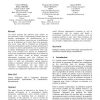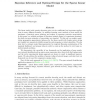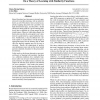1215 search results - page 132 / 243 » Dimensions of machine learning in design |
EGICE
2006
14 years 27 days ago
2006
Abstract. In knowledge representation by fuzzy rule based systems two reasoning mechanisms can be distinguished: conjunction-based and implication-based inference. Both approaches ...
ITS
2000
Springer
14 years 25 days ago
2000
Springer
This paper presents an approach to the design of a learning environment in a mathematical domain (elementary combinatorics) where problem solving is based more on modelling than o...
JMLR
2008
13 years 9 months ago
2008
The linear model with sparsity-favouring prior on the coefficients has important applications in many different domains. In machine learning, most methods to date search for maxim...
ML
2008
ACM
13 years 7 months ago
2008
ACM
Kernel functions have become an extremely popular tool in machine learning, with an attractive theory as well. This theory views a kernel as implicitly mapping data points into a ...
ICML
2006
IEEE
14 years 10 months ago
2006
IEEE
Kernel functions have become an extremely popular tool in machine learning, with an attractive theory as well. This theory views a kernel as implicitly mapping data points into a ...



